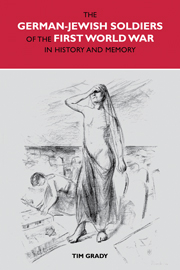Book contents
- Frontmatter
- Contents
- Acknowledgements
- List of Abbreviations
- Introduction
- 1 Dying: War, Mutilation and Mass Death, 1914–18
- 2 Mourning: Defeat, Revolution and Memorialisation, 1918–23
- 3 Commemorating: War Veterans, Ritual and Remembrance, 1923–29
- 4 Forgetting: Nazism, Front Fighters and Destruction, 1929–45
- 5 Discovering: War Victims, War Crimes and Reconstruction, 1945–60
- 6 Embracing: The Growth of Holocaust Awareness and Acknowledgement of the Jewish Soldiers, 1960–80
- Conclusion
- Bibliography
- Index
Conclusion
- Frontmatter
- Contents
- Acknowledgements
- List of Abbreviations
- Introduction
- 1 Dying: War, Mutilation and Mass Death, 1914–18
- 2 Mourning: Defeat, Revolution and Memorialisation, 1918–23
- 3 Commemorating: War Veterans, Ritual and Remembrance, 1923–29
- 4 Forgetting: Nazism, Front Fighters and Destruction, 1929–45
- 5 Discovering: War Victims, War Crimes and Reconstruction, 1945–60
- 6 Embracing: The Growth of Holocaust Awareness and Acknowledgement of the Jewish Soldiers, 1960–80
- Conclusion
- Bibliography
- Index
Summary
In late 1995, the city authorities in Ingolstadt announced their intention to construct a central memorial for the victims of National Socialism. Their plan called for the integration of a number of existing war memorials into a new remembrance site to be located in the city's large Luitpold Park. In 1998, after much local debate, a new memorial site designed by the Bavarian artist Dagmar Pachtner was finally unveiled. Pachtner's concept envisaged dismantling many of the city's existing memorials and then reordering them in a chronological line according to the time of their original construction. Central to Pachtner's design was a separate limestone block from Israel for the German-Jewish soldiers of the First World War. ‘This new flat stone has no inscription,’ explained Pachtner. ‘It is for the Jewish German soldiers who fought for Germany in the First World War and were murdered during the National Socialist era.’
On one level, Ingolstadt's new remembrance site revealed the juxtaposition of the German-Jewish war dead with the Holocaust. ‘It [the stone] stands for the integration and exclusion of Jewish citizens in all time periods of our century,’ suggested the art historian Stefanie Endlich, ‘a theme which, even for the First World War, can no longer be discussed without considering the later genocide.’ However, the use of a distinct memorial block for the German-Jewish war dead of the First World War, quarried not in Germany but in Israel, also demonstrated how the Jewish soldiers have gradually found themselves separated from the remembrance of their non-Jewish comrades.
- Type
- Chapter
- Information
- Publisher: Liverpool University PressPrint publication year: 2011



